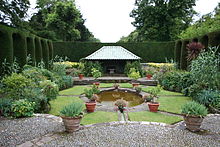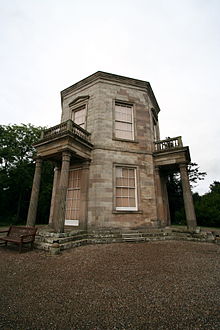Mount Stewart (County Down)
Mount Stewart ( Irish Moin Stíobhaird ) is a mansion with a garden in County Down, Northern Ireland . The 18th century house is on the east bank of Strangford Lough , a few miles outside the town of Newtownards near the village of Greyabbey . It was the Irish seat of the Vane-Tempest-Stewart family , Marquesses of Londonderry . Now listed as a Grade A Historic Building, it is managed by the National Trust . The house and its furnishings trace the history of the Vane-Tempest-Stewart family, who played a leading role in British and Irish society and politics.
history
Mount Stewart was designed by the Stewart family (later: Vane-Tempest-Stewart ), who had held the title of Marquess of Londonderry since 1816 . The family bought the property in 1744 with money that Alexander Stewart (1699–1781) had earned. He acquired his wealth with the textile trade, especially the trade in linen . The house was then called Mount Pleasant .
Alexander Stewart's son, Robert Stewart , became the first Marquess of Londonderry. Around 1800 he had a west wing added. He died in 1821, leaving the house to his son, also named Robert , better known as Viscount Castlereagh , who served as Secretary of State as one of Britain's best-known officials . Castlereagh grew up in Mount Stewart until he went to the University of Cambridge .
Lord Castlereagh inherited his father's title just a year before his own death. The next owner of the house was his half-brother Charles Vane (1778-1854). He married twice and his second marriage significantly increased the family fortune. His second wife was Lady Frances Anne Vane-Tempest . She was the most famous heiress of her time. This prompted the refurbishment and expansion of the now newly named Mount Stewart. While the Londonderrys invested £ 150,000 in refurbishing their family home, they donated only £ 30 to tackle the great famine in Ireland in the 1840s, despite the fact that their lands were directly affected by the famine. This highlights the inhumanity that prevailed in Ireland at the time. This rebuilding resulted in what is now Mount Stewart's exterior. The small Georgian house and the small portico on the west wing were demolished and the house expanded to 11 bays. A huge portico was added to the center of the entrance facade and a smaller "half portico" was added on the other side.
The marriage also gave the family much of what is now Vane Tempest property, including land. Wynyard Park in County Durham was also rebuilt in the neo-classical style . The couple bought Seaham Hall , also in County Durham, and later Holdernesse House on London's Park Lane. The latter was later renamed Londonderry House .
The 4th Marquess of Londonderry married Viscount Powerscourt's widow and lived in her home at Powerscourt Gardens near Dublin . The 5th Marquess lived in the inherited estate of his wife, Plas Machynlleth in Wales and their son, the 6th Marquess , lived in Wynyard Hall . This long period of neglect almost destroyed Mount Stewart.
The 7th Marquess (1878–1949), a well-known UUP politician, and his wife brought new life to the house and its simply designed property. The inherited home of the Marchioness of Londonderry was the Scottish Dunrobin Castle . The gardens of this castle inspired the designers of those at Mount Stewart. She also had a large part of the interior remodeled, e.g. B. the huge salon, the smoking room, the Castlereagh room and many of the bedrooms for guests. She named the latter after European cities, e.g. B. Rome or Moscow .
The gardens
After decorating the house, the Marchioness had the gardens remodeled as lavishly as possible. Before her husband succeeded her as Marquess in 1915, the gardens were simple lawns with large ornamental pots. She added the Shamrock Garden and the Sunken Garden , enlarged the lake, added the Spanish Garden with a small hut, the Italian Garden , the Dodo Terrace with its "menagerie" made of cement figures and a fountain pond, and walks in Lily Wood and the rest of the property. In 1957 she donated the gardens to the National Trust .
The National Trust
The National Trust took over the gardens in 1957. The last heiress (and the last descendant of the 7th Marquess), Lady Mairi Bury (née Vane-Tempest-Stewart, widow of Viscount Bury) left the house and most of its interior furnishings in 1977 also the National Trust. The National Trust operates the property under the name "Mount Stewart House, Garden & Temple of the Winds". Lady Mairi Bury was the last member of the Londonderry family to live in Mount Stewart and the last member of the Anglo-Irish family in Ireland. She died at the age of 88 on November 18, 2009 in Mount Stewart.
In 1999, the Mount Stewart Gardens were put on the UK's "attempt list" of properties for possible nomination as UNESCO World Heritage .
In 2015, the National Trust completed the extensive restoration of the house and its interior.
The House
Mount Stewart has seen many good times and many bad times. During the lifetime of the 3rd Marquess, it was used almost continuously and extensively expanded into the main family seat. It was fundamentally expanded and supplemented with rooms that could accommodate the growing art collection, furniture and other treasures of the family. The most important room was and still is the salon. From there you have an overview of the main gardens and in the past you could also see Strangford Lough from there . Another important room was the dining room, which faces the front facade and used to be almost twice as large as it is today. At some point after its layout and lavish furnishings, it was remodeled to create a new kitchen. One of Mount Stewart's most amazing rooms is the private chapel. This hidden gem is a double-height room with stained glass windows and Italian wall paintings.
The estate
The current Mount Stewart estate covers 40 acres and is home to a large lake and many monuments.
Temple of the Winds
This octagonal structure was inspired by the Grand Tour that the 1st Marquess took in his youth. Many country houses in the UK have replicas of the “temples” that their owners saw on their tours of the Mediterranean . The one at Mount Stewart is similar to the one at Shugborough Hall and West Wycombe Park . It was designed by the architect James 'Athenian' Stuart in 1782/83 after the model of the Tower of the Winds in Athens.
Tír na nÓg
The burial ground of the Vane Tempest Stewarts is called Tír na nÓg , Irish for “land of the young”. The 7th Marquess and his wife Edith, Lady Londonderry, are buried here, surrounded by statues of Irish saints. Her daughter, Lady Mairi Bury, was also buried here in November 2009.
Individual evidence
- ↑ Mount Stewart, Newtownards, Co. Down . University College Cork. ( Memento of the original from October 22, 2007 in the Internet Archive ) Info: The archive link was inserted automatically and has not yet been checked. Please check the original and archive link according to the instructions and then remove this notice. Retrieved September 30, 2015.
- ↑ Lady Mairi Bury of Mount Stewart, socialite . The Scotsman (November 22, 2009). Retrieved September 30, 2015.
- ↑ Lady Mairi Bury: Chatelaine of Mount Stewart who met Hitler and Von Ribbentrop . In: The Independent . November 27, 2009.
- ^ Chatelaine of Mount Stewart who preserved great house's gardens . In: The Irish Times . December 12, 2009. Retrieved September 30, 2015.
- ↑ Lady Mairi Bury . In: The Daily Telegraph . January 13, 2010. Accessed September 30, 2015.
- ↑ Mount Stewart Gardens . UNESCO. Retrieved September 30, 2015.
- ↑ Mount Stewart House restored in £ 8m refurbishment . In: BBC News . April 17, 2015. Retrieved September 30, 2015.
Web links
Coordinates: 54 ° 33 '18 " N , 5 ° 36' 28.8" W.




